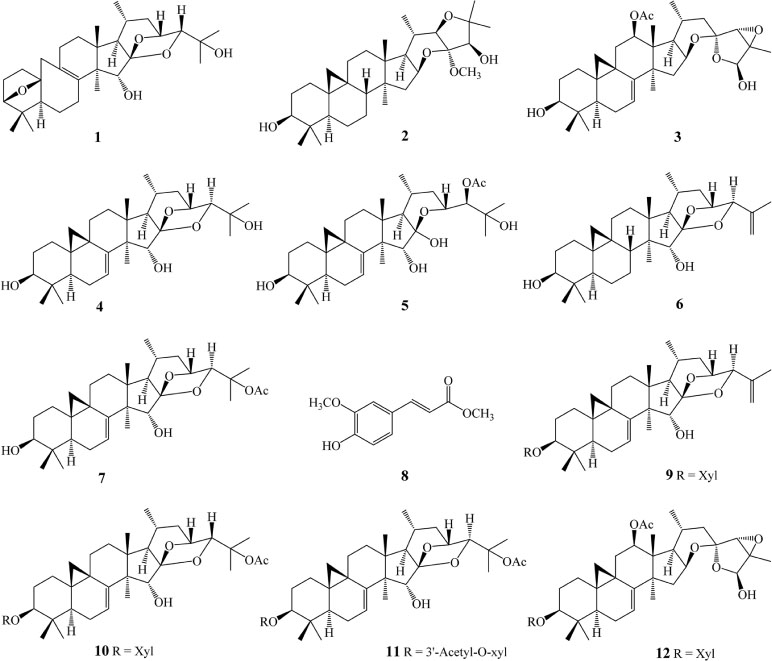Nat Prod Sci.
2018 Sep;24(3):194-198. 10.20307/nps.2018.24.3.194.
Chemicals from Cimicifuga dahurica and Their Inhibitory Effects on Pro-inflammatory Cytokine Production by LPS-stimulated Bone Marrow-derived Dendritic Cells
- Affiliations
-
- 1Institute of Marine Biochemistry (IMBC), Vietnam Academy of Science and Technology (VAST), 18-Hoang Quoc Viet, Hanoi, Vietnam.
- 2College of Pharmacy, Chungnam National University, Daejeon 34134, Republic of Korea. yhk@cnu.ac.kr, syyang@cnu.ac.kr
- 3Hanoi University of Pharmacy, 13-15 Le Thanh Tong, Hanoi, Vietnam.
- 4School of Medicine and Jeju Research Center for Natural Medicine, Jeju National University, Jeju 63243, Republic of Korea. yskoh7@jejunu.ac.kr
- KMID: 2422012
- DOI: http://doi.org/10.20307/nps.2018.24.3.194
Abstract
- Inflammation is a biological response caused by overactivation of the immune system and is controlled by immune cells via a variety of cytokines. The overproduction of pro-inflammatory cytokines enhances abnormal host immunity, resulting in diseases such as rheumatoid arthritis, cardiovascular disease, Alzheimer's disease, and cancer. Inhibiting the production of pro-inflammatory cytokines such as interleukin (IL)-12p40, IL-6, and tumor necrosis factor (TNF)-α might be one way to treat these conditions. Here, we investigated the anti-inflammatory activity of compounds isolated from Cimicifuga dahurica (Turcz.) Maxim., which is traditionally used as an antipyretic and analgesic in Korea. In primary cell culture assays, 12 compounds were found to inhibit the production of pro-inflammatory cytokines (IL-12p40, IL-6, and TNF-α) in vitro in bone marrow-derived dendritic cells stimulated with LPS.
MeSH Terms
Figure
Reference
-
1. Schwab JM, Serhan CN. Curr Opin Pharmacol. 2006; 6:414–420.2. Efron PA, Tsujimoto H, Bahjat FR, Ungaro R, Debernardis J, Tannahill C, Baker HV, Edwards CK, Moldawer LL. J Endotoxin Res. 2005; 11:145–160.3. Ueno H, Klechevsky E, Morita R, Aspord C, Cao T, Matsui T, Di Pucchio T, Connolly J, Fay JW, Pascual V, Palucka AK, Banchereau J. Immunol Rev. 2007; 219:118–142.4. Gubler U, Chua AO, Schoenhaut DS, Dwyer CM, McComas W, Motyka R, Nabavi N, Wolitzky AG, Quinn PM, Familletti PC. Proc Natl Acad Sci U S A. 1991; 88:4143–4147.5. Kishimoto T. Int Immunol. 2010; 22:347–352.6. Gahring LC, Carlson NG, Kulmar RA, Rogers SW. Neuroimmunomodulation. 1996; 3:289–303.7. Beutler B, Cerami A. Nature. 1986; 320:584–588.8. Chinese Pharmacopoeia Commission. Pharmacopoeia of the People's Republic of China. 1. china: China Medical Science and Technology Press;2010. p. 68–69.9. Qin R, Zhao Y, Zhao Y, Zhou W, Lv C, Lu J. Fitoterapia. 2016; 115:52–56.10. Zhang LL, Si JY, Zhang LJ, Xiao-Wei H, Lin L, Li RY, Chen D, Cao L. Chin J Integr Med. 2016; 1–9.11. Tian Z, Si J, Chang Q, Zhou L, Chen S, Xiao P, Wu E. BMC Cancer. 2007; 7:237.12. Lv C, Yang F, Qin R, Qi Z, Zhou W, Lu J. Bioorg Med Chem Lett. 2017; 27:3305–3309.13. Thao NP, Kim JH, Thuy Luyen BT, Dat NT, Kim YH. Int J Biol Macromol. 2017; 98:526–534.14. Thao NP, Luyen BT, Lee JS, Kim JH, Kim YH. Bioorg Med Chem Lett. 2017; 27:1874–1879.15. Thao NP, Luyen BTT, Lee JS, Kim JH, Dat NT, Kim YH. J Nat Prod. 2017; 80:1867–1875.
- Full Text Links
- Actions
-
Cited
- CITED
-
- Close
- Share
- Similar articles
-
- Anti-inflammatory Activity of Carpinus tschonoskii Leaves Extract in R848-stimulated Bone Marrow-derived Macrophages and Dendritic Cells
- Anti-inflammatory Effect of Plocamium telfairiae Extract in LPS-stimulated Bone Marrow-derived Macrophages and Dendritic Cells
- Acrosorium polyneurum Extract Inhibits the LPS-Induced Inflammatory Response by Impairing the MAPK and NF-κB Pathways
- 3-Hydroxy-4,7-megastigmadien-9-one, Isolated from Ulva pertusa Kjellman, Inhibits LPS-Induced Inflammatory Response by Down-Regulating Mitogen-Activated Protein Kinase and NF-κB Pathways
- Flaviviruses Induce Pro-inflammatory and Anti-inflammatory Cytokines from Murine Dendritic Cells through MyD88-dependent Pathway


